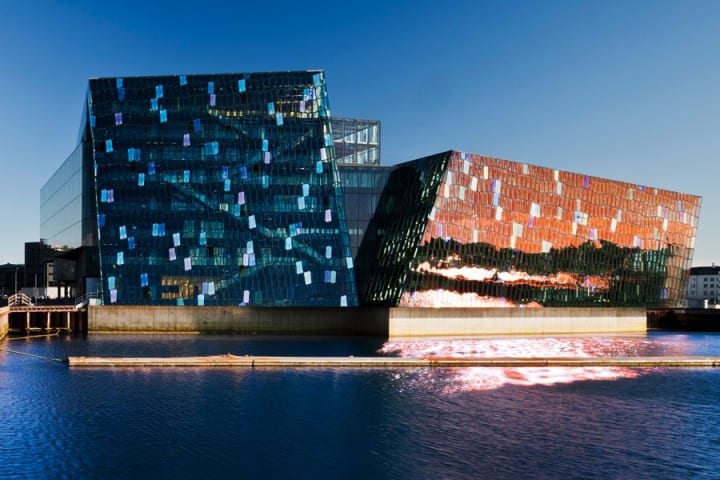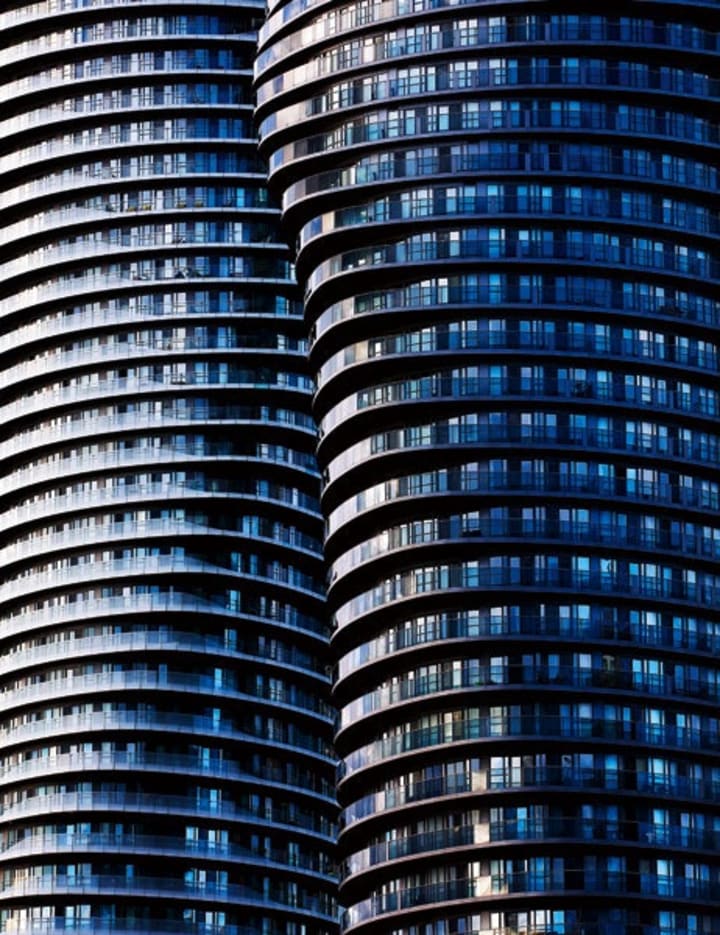10 Best Designed Buildings in the World From Top Architects
Building design at its visionary best engages, exhilarates, and inspires. It possesses a quality—almost indescribable—that embodies design ingenuity, connection to place, and, above all, imagination. But today’s architectural monuments aren’t meant only to be admired from afar. “It’s not about creating an icon, but shaping public space,” says Steven Holl, referring to the Linked Hybrid, the eight-tower residential-office-retail complex his firm designed in Beijing. “You can’t understand it unless you’re over, under, and around it.” The Linked Hybrid is also “ultragreen,” Holl notes, pointing to the 655 geothermal wells beneath the buildings that provide heating and cooling. Like the best architects of his generation, Holl marries social and environmental responsibility to aesthetic ambition.

1. HARPA Concert Hall and Conference Center

ReykjavÍk, Iceland
Henning Larsen Architects and Batteríið Architects
Even before its official opening, this gemlike venue breathed new life into the Icelandic capital’s once-sleepy harbor, captivating locals and luring visitors with its kaleidoscopic façade of multicolor glass. The crystalline shell, conceived by artist Olafur Eliasson, wonderfully complements the structure’s aggregate of jagged, geometric volumes. At night, exterior LED strips activate, transforming the waterfront landmark into a shimmering beacon of beauty.
Dubai, United Arab Emirates Skidmore, Owings & Merrill, 2010 Rising a dizzying 2,717 feet above the desert, this spectacular supertower reigns as the tallest structure in the world. Its 162 floors contain offices, residences, restaurants, an Armani hotel, and an observation deck, 124 stories up. The strength of its design stems not only from its awe-inspiring verticality but also from its sleek silhouette. Wrapped in a glass curtain wall with steel mullions that catch the Arabian sun, the building tapers gradually from its Y-shaped base, with setbacks culminating in a 700-foot spire.Photo: Iwan Baan
2. Burj Khalifa

Dubai, United Arab Emirates
Skidmore, Owings & Merrill
Rising a dizzying 2,717 feet above the desert, this spectacular supertower reigns as the tallest structure in the world. Its 162 floors contain offices, residences, restaurants, an Armani hotel, and an observation deck, 124 stories up. The strength of its design stems not only from its awe-inspiring verticality but also from its sleek silhouette. Wrapped in a glass curtain wall with steel mullions that catch the Arabian sun, the building tapers gradually from its Y-shaped base, with setbacks culminating in a 700-foot spire.
Singapore Wilkinson Eyre Architects, Grant Associates, 2012 Side-by-side parabolic conservatories of glass and steel anchor this cutting-edge botanical garden in Singapore’s booming Marina Bay district. Named the 2012 building of the year by the World Architecture Festival, the Wilkinson Eyre–designed structures replicate distinct climates—one dry, the other humid—allowing for diverse attractions like a flower meadow and a misty mountain forest.Photo: Craig Sheppard
3. Gardens by the Bay

Singapore
Wilkinson Eyre Architects, Grant Associates
Side-by-side parabolic conservatories of glass and steel anchor this cutting-edge botanical garden in Singapore’s booming Marina Bay district. Named the 2012 building of the year by the World Architecture Festival, the Wilkinson Eyre–designed structures replicate distinct climates—one dry, the other humid—allowing for diverse attractions like a flower meadow and a misty mountain forest.
No less extraordinary is the adjoining grove of vertical gardens by Grant Associates. Visitors can stroll an elevated walkway connecting the “supertrees,” some of which are fitted with photovoltaic cells to harness solar energy.Photo: Craig Sheppard
No less extraordinary is the adjoining grove of vertical gardens by Grant Associates. Visitors can stroll an elevated walkway connecting the “supertrees,” some of which are fitted with photovoltaic cells to harness solar energy.
Beijing Steven Holl Architects, 2009 Composed of eight connected towers, this mixed-use complex represents a compelling vision for 21st-century urban development. To combat the isolation often associated with luxury residential buildings and gated communities, the architects placed wide, open passages at ground level, ushering pedestrians into a series of public spaces that include gardens, shops, restaurants, and schools.Photo: Shu He
4. Linked Hybrid

Beijing
Steven Holl Architects
Composed of eight connected towers, this mixed-use complex represents a compelling vision for 21st-century urban development. To combat the isolation often associated with luxury residential buildings and gated communities, the architects placed wide, open passages at ground level, ushering pedestrians into a series of public spaces that include gardens, shops, restaurants, and schools.
High overhead, glass-and-steel bridges also contain retail spaces and a café, providing another sphere for community-fostering encounters between visitors and neighbors.Photo: Shu He
High overhead, glass-and-steel bridges also contain retail spaces and a café, providing another sphere for community-fostering encounters between visitors and neighbors.
London Renzo Piano Building Workshop, 2012 Familiar to watchers of last summer’s Olympic Games, this 72-story skyscraper—the tallest in Western Europe—has transformed the British capital’s skyline, rising arrestingly on the southern banks of the Thames. Inspired by church steeples, the structure comprises eight angled glass façades that variously reflect the surrounding city and sky and offer crystal-clear glimpses inside. Intended by Piano to act as a vertical village, the multifunctional building includes offices, apartments, restaurants, and a hotel—all crowned by a recently opened observation platform, which affords stunning views up to 40 miles in every direction.Photo courtesy of Sellar Property Group
5. The Shard

London
Renzo Piano Building Workshop
Familiar to watchers of last summer’s Olympic Games, this 72-story skyscraper—the tallest in Western Europe—has transformed the British capital’s skyline, rising arrestingly on the southern banks of the Thames. Inspired by church steeples, the structure comprises eight angled glass façades that variously reflect the surrounding city and sky and offer crystal-clear glimpses inside. Intended by Piano to act as a vertical village, the multifunctional building includes offices, apartments, restaurants, and a hotel—all crowned by a recently opened observation platform, which affords stunning views up to 40 miles in every direction.
Dallas Morphosis Architects, 2012 Architect Thom Mayne, the Pritzker Prize–winning founder of Morphosis, is famous for breaking the mold, and his latest building is no exception. Sheathed in panels of textured concrete, it consists of a five-story cube, fractured at one corner and set atop a sweeping plinth planted with Texas grasses. Slashed across the cube’s exterior is a dramatic glass-enclosed escalator, which whisks visitors to the top-floor entrance to the exhibits.Photo: Roland Halbe
6. Perot Museum of Nature and Science

Dallas
Morphosis Architects
Architect Thom Mayne, the Pritzker Prize–winning founder of Morphosis, is famous for breaking the mold, and his latest building is no exception. Sheathed in panels of textured concrete, it consists of a five-story cube, fractured at one corner and set atop a sweeping plinth planted with Texas grasses. Slashed across the cube’s exterior is a dramatic glass-enclosed escalator, which whisks visitors to the top-floor entrance to the exhibits.
Water Mill, New York Herzog & de Meuron, 2012 Topped by a double-gable roof of white corrugated metal, the Parrish’s strikingly horizontal new home melds brilliantly with its setting, nodding in form to both the traditional barns and the cottagelike artist studios that have long been associated with Long Island’s East End.Photo: Roland Halbe
7. Parrish Art Museum

Water Mill, New York
Herzog & de Meuron
Topped by a double-gable roof of white corrugated metal, the Parrish’s strikingly horizontal new home melds brilliantly with its setting, nodding in form to both the traditional barns and the cottagelike artist studios that have long been associated with Long Island’s East End.
Inside the poured-concrete structure—devised by architect Ascan Mergenthaler, a senior partner at the Swiss firm—inviting galleries joined by a central spine are warmed by natural-wood ceilings and abundant skylights.Photo: Iwan Baan
Inside the poured-concrete structure—devised by architect Ascan Mergenthaler, a senior partner at the Swiss firm—inviting galleries joined by a central spine are warmed by natural-wood ceilings and abundant skylights.
Guangzhou, China Zaha Hadid Architects, 2010 China’s building boom has produced some audacious projects, and few are as eye-popping as Hadid’s performance center for the southern industrial city of Guangzhou. The venue consists of two dynamic fluid-form structures, the larger housing an undulating, gilded 1,800-seat hall and the smaller home to a more intimate 400-seat space.Photo: Hufton + Crow/View/Artur Images
8. Guangzhou Opera House

Guangzhou, China
Zaha Hadid Architects
China’s building boom has produced some audacious projects, and few are as eye-popping as Zaha Hadid’s performance center for the southern industrial city of Guangzhou. The venue consists of two dynamic fluid-form structures, the larger housing an undulating, gilded 1,800-seat hall and the smaller home to a more intimate 400-seat space.
Both buildings are clad in great expanses of steel-framed glass and granite panels—the complexity of which led to challenges during construction and in ongoing maintenance. But the futuristic complex is an emphatic statement on the ambitions of 21st-century China.Photo: Christian Richters/View/Artur Images
Both buildings are clad in great expanses of steel-framed glass and granite panels—the complexity of which led to challenges during construction and in ongoing maintenance. But the futuristic complex is an emphatic statement on the ambitions of 21st-century China.
Seville, Spain J. Mayer H. Architects, 2011 When excavation for a parking garage unearthed Roman artifacts in Seville’s Plaza de la Encarnación, city officials opted to commission this welcoming landmark instead.Photo: Inigo Bujedo Aguirre/View/Artur Images
9. Metropol Parasol

Seville, Spain
J. Mayer H. Architects
When excavation for a parking garage unearthed Roman artifacts in Seville’s Plaza de la Encarnación, city officials opted to commission this welcoming landmark instead.
Some 90 feet high and nearly 500 feet long, the billowing timber pavilion is part pergola, part urban parlor. Viewing platforms are perched atop the organic forms, which also shelter restaurants and an archaeological museum.Photo: Fernando Alda
Some 90 feet high and nearly 500 feet long, the billowing timber pavilion is part pergola, part urban parlor. Viewing platforms are perched atop the organic forms, which also shelter restaurants and an archaeological museum.
Mississauga, Ontario MAD Architects, 2012 These residential high-rises strike a voluptuous profile in Toronto’s largest suburb. With continuous balconies and elliptical floor plans, the 50- and 56-story skyscrapers appear to shimmy and twist, each around its own axis.Photo: Roland Shainidze
10. Absolute World

Mississauga, Ontario
MAD Architects
These residential high-rises strike a voluptuous profile in Toronto’s largest suburb. With continuous balconies and elliptical floor plans, the 50- and 56-story skyscrapers appear to shimmy and twist, each around its own axis.
Image may contain Building Housing Condo Office Building City High Rise Town Urban and Metropolis
Such creative formmaking is the focus of the young Beijing firm, whose design was executed in coordination with Burka Architects. Founded by Yansong Ma in 2004, MAD has earned a reputation for innovative edifices such as Inner Mongolia’s Ordos Museum. Like that project, the Absolute towers offer a refreshing take on a familiar building type.Photo: Tom Arban
Such creative formmaking is the focus of the young Beijing firm, whose design was executed in coordination with Burka Architects. Founded by Yansong Ma in 2004, MAD has earned a reputation for innovative edifices such as Inner Mongolia’s Ordos Museum. Like that project, the Absolute towers offer a refreshing take on a familiar building type.
About the Creator
Mr Ceaser
NEW THINKING,LEARNER






Comments
There are no comments for this story
Be the first to respond and start the conversation.